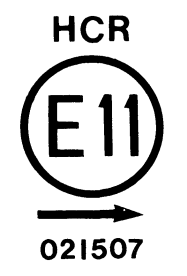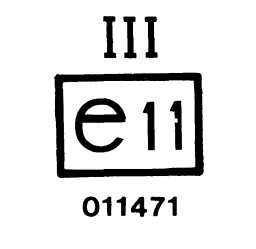|
| 6(4) | The exemption from the need for a small trailer to be fitted with any stop lamp or direction indicator when those on the towing vehicle are visible to an observer 6 m behind the trailer will not apply to a trailer manufactured on or after 1st October 1990. |
| 11(2) | Amber warning beacons may be fitted to vehicles used for:–
(ii) the removal or immobilisation of vehicles in exercise of a statutory power or duty; or
(iii) escort purposes when travelling at a speed not exceeding 25 mph.
|
| 11(2) | Reflected orange light is permitted from a sign fitted to the rear of a vehicle carrying dangerous substances. |
| 11(3) | A green and white chequered domed lamp is permitted on an ambulance control vehicle. |
| 11(2) and Sch 9 | A side marker lamp is permitted to be amber or, if fitted within 1 m of the rear of the vehicle, red. |
| 11(2) and Sch 17 | A side retro reflector is permitted to be red if fitted within 1 m of the rear of the vehicle. |
| 14(2) | A requirement is introduced for lamps on new pedal cycles in future to be fitted with filament lamps that comply with the British Standard specification for Filament Lamps for Cycles, published by the British Standards Institution under the reference 6873 : 1988. |
| 15 | A new general requirement is introduced concerning the electrical connections for lamps. |
| 16 | The provision is amended so as to permit the fitting of special warning lamps at the front of emergency vehicles and the prohibition in the corresponding previous regulation on the fitting of a warning beacon other than a blue warning beacon, or a device resembling such a beacon, is removed. Nevertheless, regulation 11 prohibits the fitting of warning beacons except as specified in that regulation. |
| 19 | A new requirement is introduced to clarify the position regarding the obscuration of lamps and reflectors by movable parts of a vehicle. |
| 20(1), Table, items 3 and 4 | A new requirement is introduced for loads projecting either laterally or beyond the rear of a vehicle to be fitted with reflectors in addition to lamps. |
| 20(1), Table, item 5 | A new requirement is introduced for loads projecting beyond the front of a vehicle to carry lamps and reflectors. |
| 23(2) | A new requirement is introduced for a headlamp levelling device, a dim-dip device or running lamp and a hazard warning signal device to be maintained in good working order. |
| 27, Table, item 5 | The provision is amended so to permit the use of a hazard warning signal device whilst travelling on a motorway or unrestricted dual-carriageway to warn following drivers of a need to slow down due to a temporary obstruction ahead. |
| Schedules | |
| 1, Table I | A new provision exempts from the requirement for a dim-dip device to be fitted a vehicle that meets fully the provisions of Council Directive 76/756/EEC, as amended, including, in particular, the provisions for alignment of dipped-beam headlamps. |
| 1, Tables I and VI and Sch 9 | A requirement is introduced for new goods vehicles and trailers over 6 m long to be fitted with amber side marker lamps every 3 m along their sides.
Exemptions are provided for:–
(i) a vehicle which meets fully the provisions of Council Directive 76/756/EEC, as amended;
(ii) a vehicle having a maximum speed not exceeding 25 mph;
(iii) agricultural and works trailers;
(v) a vehicle proceeding to a works for completion; and
(vi) a trailer used for the carriage and launching of a boat.
|
| 1, Tables I and VI and Sch 13 | A requirement is introduced for new motor vehicles and trailers over 2.1 m wide to be fitted with end-outline marker lamps. Exemptions are provided for:–
(i) a vehicle having a maximum speed not exceeding 25 mph;
(ii) agricultural and works trailers; and
(iii) a vehicle proceeding to a works for completion.
|
| 1, Table I | The requirement for a works truck to be fitted with a rear registration plate lamp is revoked. |
| 1, Table I | A requirement is introduced for an invalid carriage which can exceed 4 mph to be fitted with direction indicators and a hazard warning signal device. |
| 1, Table VI | Trailers constructed or adapted for the carriage and launching of a boat are exempt from the requirement for front position lamps. |
| 1, Table VI | The exemption for an agricultural trailer and a works trailer from the requirement to be fitted with direction indicators will not apply to trailers manufactured after 1st October 1990. |
| 1, Table VI and Sch 21 | A new requirement is introduced for trailers manufactured on or after 1st October 1990 to be fitted with white front reflectors. Agricultural and works trailers are exempt. |
| 2, Part I, para. 3 | The inward angle of visibility for a front position lamp fitted to a trailer is reduced to 5°. |
| 2, Part I, para. 5(c) | A front position lamp fitted to “any other vehicle” (a pedal cycle, a horse-drawn vehicle, an invalid carriage having a maximum speed not exceeding 4 mph and a vehicle drawn or propelled by hand), in each case manufactured or first used on or after 1st October 1990, will be required to bear an approval mark in accordance with Council Directive 76/758/EEC (27.7.76, OJL 262, 27.9.76, p. 54) or ECE Regulation 7 of 27.5.67, or the British Standard mark “BS 6102/3”. |
| 2, Part II | The maximum number of front position lamps fitted to a solo motor bicycle first used on or after 1st April 1991 is restricted to two. |
| 3 | The title of this Schedule is amended to refer to Dim-Dip and Running Lamps, the specifications for which are included in the Schedule. |
| 4, Part I, para. 4 | The requirements for the alignment of dipped-beam headlamps are specified. |
| 4, Part I, para. 12(b) and Sch 23 | A requirement is introduced for an indication of the downward inclination (vertical aim) of the dipped-beam headlamps to be shown on a motor vehicle first used on or after 1st April 1991. |
| 4, Part II, para. 1 | A requirement is introduced to prevent a motor vehicle first used on or after 1st April 1991 from being capable of showing more than 2 dipped-beam headlamps at one time. Two pairs may be fitted only if one pair is for use in countries where driving is on the right-hand side of the road. |
| 5, Part II | A requirement is introduced for optional main-beam headlamps fitted to motor vehicles first used on or after 1st April 1991 to bear an approval mark. |
| 6 | The maximum number of front fog lamps fitted to a motor vehicle first used on or after 1st April 1991 is restricted to 2. There was no previous restriction. |
| 6, para. 4 | A requirement for the alignment of front fog lamps is specified. |
| 7 | Consistent with the Schedules for other lamps, this Schedule has been sub-divided into Part I, covering obligatory direction indicators and Part II, covering optional direction indicators. Part III contains the diagrams showing horizontal angles of visibility. |
| 7, Part I, paras. 1, 2 and 5 | Provision is made for Categories 1a, 1b, 2a and 2b direction indicators. The effect is that front direction indicators fitted close to headlamps are required to be brighter than those fitted beyond a specified distance. |
| 7, Part I, para. 2 | The requirement regarding the relative positioning of rear direction indicators and rear position lamps has not been reenacted. The minimum separation distances between direction indicators fitted to invalid carriages are specified. |
| 10, Part I, para. 5 | Rear position lamps fitted to pedal cycles etc are permitted to comply with BS 6102: Part 3 1986 or to be approved to a European standard, as an alternative to the previous requirement. |
| 12, Part II, para. (b) | The requirement for a stop lamp fitted to a pedal cycle to bear an approval mark has not been re-enacted. |
| 12, Part II, para. (c) | An optional stop lamp fitted in the rear window of a motor vehicle first used on or after 1st April 1991 is required to emit light having an intensity of between 20 and 60 candelas when measured directly in front of the lamp. |
| 22 | A diagram illustrates where unlit parking is not permitted near a junction. |



